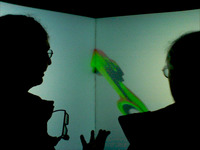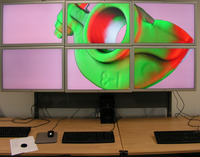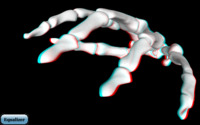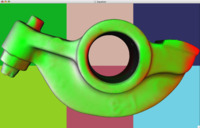Table of Contents
Videos
2D (sort-first)
2D (or sort-first) parallel rendering. All rendering tasks execute on a
single machine for demonstration purposes. A deployment configuration would
use one GPU per window to parallelize the rendering.
Volume rendering using three GPUs and dynamic 2D load-balancing. The tiling
is adapted each frame automatically and transparently to the application by
Equalizer. The data set has 256^3 voxels, and is rendered using 2560 slices
using the eVolve scalable volume renderer.
DB (sort-last)
Parallel Volume Rendering using DB (sort-last) task decomposition with
eVolve.
Polygonal rendering using two GPUs and dynamic DB (sort-last)
load-balancing. The tiling is adapted each frame automatically and
transparently to the application by Equalizer. The data set has 7.2M
triangles, and is colored differently on each GPU to illustrate the task
decomposition.
Other
Various multi-display example setups using the Equalizer parallel rendering
framework.
Direct send compositing parallelizes the compositing step for DB compounds
across all render channels, to keep the per-channel IO load constant.
EYE (or stereo) parallel rendering task decomposition. All rendering tasks
execute on a single machine for demonstration purposes. A deployment
configuration would use one GPU per window to parallelize the rendering.
DPlex (time-multiplex, AFR) parallel rendering task decomposition. All
rendering tasks execute on a single machine for demonstration purposes. A
deployment configuration would use one GPU per window to parallelize the
rendering.
Pixel-based parallel rendering task decomposition. All rendering tasks
execute on a single GPU for demonstration purposes. A deployment
configuration would use one GPU per window to parallelize the rendering.
Multi-level task decomposition using sort-last and sort-first compounds with
2D load-balancing.
Screenshots
Click on the images to get a high resolution version.
 A terrain visualization software, eqSmart, on the 24 megapixel display wall at
the University of Zürich (7680x3200)
A terrain visualization software, eqSmart, on the 24 megapixel display wall at
the University of Zürich (7680x3200)
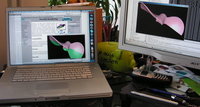 eqPly running on a MacBook Pro using a Windows XP machine as a rendering
client in a sort-last configuration.
eqPly running on a MacBook Pro using a Windows XP machine as a rendering
client in a sort-last configuration.
 A six pipe sort-last, direct-send configuration using channel colors to
illustrate the database decomposition (model patches) and the parallel result
composition (background)
A six pipe sort-last, direct-send configuration using channel colors to
illustrate the database decomposition (model patches) and the parallel result
composition (background)
Volume data sets courtesy of Computer Graphics Group, University of Erlangen,
Germany, Computer Science Institute, University of Freiburg, Germany, SFB 382
of the German Research Council (DFG) and General Electric, USA. 3D models
courtesy of Cyberware,
Stereolithography Archive at Clemson
University, XYZ RGB, Inc.
and Stanford University
Computer Graphics Laboratory.



